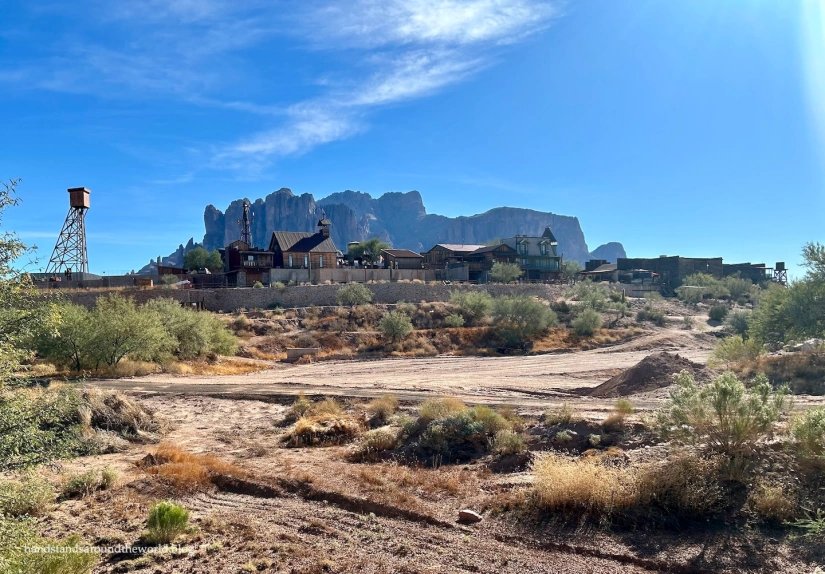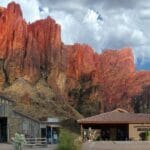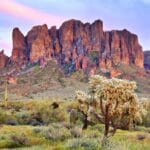The Superstition Mountains, rising dramatically from the Arizona desert, have captivated hearts and minds for centuries. This legendary range, with its rugged peaks and deep canyons, is shrouded in tales of lost gold, ancient curses, and unexplained phenomena. But beyond the myths and legends lies a fascinating landscape shaped by millions of years of geological activity. Join us as we delve into the heart of the Superstitions, exploring their towering heights, unique features, and the enduring mysteries that continue to draw adventurers and dreamers alike.
How Tall is Superstition Mountain?
The Superstition Mountains, a prominent range in Arizona, are renowned for their rugged beauty and the legendary Lost Dutchman’s Mine. Towering above the desert floor, the highest point in this captivating range is Mound Mountain, reaching a majestic height of 6,266 feet (1,910 meters). To put that into perspective, that’s like stacking about 12.5 Eiffel Towers on top of each other!
But the Superstition Mountains are more than just a single peak. This sprawling range stretches across a vast area, encompassing approximately 72 kilometers (45 miles) in length and 26 kilometers (16 miles) in width. That’s a whopping 160,000 acres of wild, rugged beauty – larger than some entire cities!
This entire area is protected as the Superstition Wilderness Area, a haven for diverse plant and animal life. And within this wilderness lies Superstition Mountain, a prominent landmark that has captured imaginations for generations.
How Tall are the Superstition Mountains?
The Superstitions were once known as the Sierra de la Espuma, which translates to “Foam Mountains” in Spanish. This name likely originated from how the afternoon sun illuminates the white granite cliffs, creating a frothy, foam-like appearance. Today, we know them as the Superstition Mountains, a name steeped in legend and local lore.
While Mound Mountain holds the title of the tallest peak, the entire range boasts an impressive average elevation, making it a challenging and rewarding destination for hikers and climbers. With a maximum prominence of 1,706 feet, these mountains offer breathtaking views of the surrounding desert landscape.
What’s the story behind the Superstition Mountains?
The Superstition Mountains are steeped in a rich tapestry of history and folklore. Long before gold fever struck the hearts of prospectors, the indigenous people of the region, particularly the Apache, held these mountains sacred. They believed the mountains were imbued with spiritual energy, a place where the veil between worlds was thin.
Whispers of a curse echo through the canyons, a warning passed down through generations. Some believe the curse manifests as sudden storms, treacherous footing, or encounters with the desert’s less-than-friendly inhabitants. Others share chilling accounts of apparitions materializing in the shimmering heat or occurrences that defy rational explanation.
The legend of the Lost Dutchman’s Gold Mine is perhaps the most famous tale associated with the Superstitions. It’s a story of a German immigrant, Jacob Waltz, who supposedly stumbled upon a mother lode of gold hidden deep within the mountain’s embrace. But like many who have sought the elusive treasure, Waltz disappeared, taking the secret of its location to his grave. To this day, the Lost Dutchman’s Mine remains a tantalizing mystery, attracting adventurers and fueling countless expeditions.
What is the Hole in the Superstition Mountains?
Among the many mysteries hidden within the Superstition Mountains is a curious geological formation known simply as “the hole.” Located on the mountain’s side, the hole is a large, almost perfectly round opening, approximately 100 feet in diameter and 50 feet high, leading into a dark, unexplored chamber of unknown depth.
Geologists are still unsure how this peculiar formation came to be. Some theories suggest that it was formed gradually over centuries by the relentless forces of wind and water erosion. Others propose that the hole might be the result of a collapsed lava tube or a sinkhole—common occurrences in areas with volcanic activity.
Native American tribes have their own interpretations of the hole. Some believe it serves as a portal to the spirit world, a place where the boundaries between realms blur. Others whisper tales of a secret stash of gold, hidden deep within the earth and guarded by powerful spirits.
The hole’s inaccessibility and the treacherous terrain surrounding it have made exploration a daunting task. While a handful of daring adventurers have attempted to unlock its secrets, venturing into the dark depths, it remains largely unexplored.
What is the curse of the Superstition Mountains?
The Superstition Mountains are shrouded in an aura of mystery and intrigue, fueled by tales of a curse that has plagued those who dare to seek their hidden treasures or disrespect their sacred grounds. While some dismiss the curse as mere superstition, others believe it’s a very real phenomenon rooted in the ancient beliefs and spiritual energy of the land.
Stories abound of prospectors who met with untimely ends—vanishing without a trace, succumbing to sudden illnesses, or falling victim to freak accidents. Could these be mere coincidences, or is there something more sinister at play?
One particularly chilling tale revolves around a prospector who reportedly found a rich vein of gold. As he attempted to flee the mountains with his newfound wealth, the sky erupted in a fury, and a bolt of lightning struck him down, leaving no trace of the unfortunate soul.
While skeptics attribute these misfortunes to the harsh realities of desert life and the inherent risks of exploration, others believe they serve as a stark reminder that the Superstition Mountains demand respect.
Has the Lost Dutchman Mine Been Found?
Despite numerous expeditions and countless hours spent scouring the rugged terrain, the Lost Dutchman’s Mine remains elusive, its existence unconfirmed. The Superstition Mountains seem determined to hold onto their secrets, testing the resolve of every adventurer who dares to search for the legendary treasure.
Over the years, several individuals have claimed to have found the mine, but their “discoveries” have either proven to be hoaxes or lacked credible evidence. The lack of concrete proof has only fueled the mystery, adding to the allure of the Lost Dutchman’s elusive fortune.
In 2013, the discovery of Jesse Capen’s remains sent ripples of excitement through the treasure-hunting community. Capen, a prospector who vanished in 1891, was found with a journal and a map, sparking renewed hope that the Lost Dutchman’s secret might finally be revealed. However, deciphering Capen’s weathered notes and correlating his map to the unforgiving terrain has proven to be a formidable challenge.
Whether the Lost Dutchman’s Mine is a fact or fiction remains a subject of debate, but one thing is certain—the legend will continue to inspire adventurers and fuel imaginations for years to come.
What is the most haunted mountain range?
While the Superstition Mountains have earned a reputation for being haunted, it’s difficult to definitively crown any mountain range as the “most haunted.” The perception of a place as haunted is often subjective, influenced by local folklore, personal experiences, and cultural beliefs.
That being said, the Superstitions certainly have their fair share of spooky tales and unexplained occurrences. Many attribute the paranormal activity to the spirits of Native Americans who, according to legend, were angered by the arrival of gold-hungry explorers and now wander the mountains, protecting their sacred land. Some hikers claim to have heard voices whispering in unfamiliar languages or have felt an overwhelming sense of dread, as if unseen eyes were watching their every move.
The mountains’ association with the Lost Dutchman’s Gold Mine and the many prospectors who met with misfortune within their shadows further contribute to their haunted reputation. The spirits of those who perished searching for the mine are said to wander the canyons, forever bound to their insatiable lust for gold.
Whether you believe in the supernatural or dismiss these stories as mere folklore, there’s no denying that the Superstition Mountains have an eerie allure. The combination of their rugged beauty, rich history, and unexplained phenomena creates an atmosphere ripe for ghost stories and chilling encounters.
How Tall is the Tian Shan Mountain?
While we’ve been focusing on the Superstition Mountains, it’s fascinating to compare them to other mountain ranges around the world. The Tian Shan, often referred to as the “Mountains of Heaven,” is one such example. Located in Central Asia, the Tian Shan range stretches across several countries, including Kazakhstan, Kyrgyzstan, Uzbekistan, and northwestern China.
The highest peak in the Tian Shan range is Jengish Chokusu, soaring to an awe-inspiring height of 7,439 meters (24,406 feet). That’s more than 2,000 meters taller than the highest peak in the contiguous United States!
The Tian Shan range is not only impressive for its height but also for its ecological significance. These mountains are home to a variety of unique ecosystems, including forests of Schrenk’s Spruce, a type of evergreen that thrives at high altitudes. Lower down, the slopes boast natural forests of wild walnut and apple trees, adding to the range’s biodiversity.
How tall are the Turtle Mountains?
Interestingly, there isn’t a specific mountain range officially designated as the “Turtle Mountains.” This name doesn’t correspond to a single, well-defined mountain range in the way that names like the “Rocky Mountains” or the “Appalachian Mountains” do. It’s possible that the “Turtle Mountains” you have in mind refer to a local landmark or a smaller mountain range that is not as widely known. Names can be repeated in different locations, leading to some confusion.
It’s also worth noting that many places receive names that don’t literally describe their appearance. Perhaps the “Turtle Mountains” you’re thinking of were named for a resemblance to a turtle’s shell from a specific angle or due to a local legend or historical event.
If you’re curious about other locations that might share the name “Turtle Mountains,” a quick online search can provide more specific information and potentially lead you to the right place!
How Tall are Lunar Mountains?
When we think of mountains, we typically envision Earthly peaks reaching for the sky. But did you know that mountains also exist on other celestial bodies, including our very own Moon? These lunar mountains, known as massifs, were formed by a variety of geological processes, including volcanic eruptions and asteroid impacts.
Measuring the height of a lunar mountain is a little different than measuring mountains on Earth. Since the Moon doesn’t have oceans like Earth, there’s no official “sea level” to use as a reference point. Instead, scientists use a variety of vertical datums, each defined in relation to the Moon’s center of mass. This means that the reported height of a lunar mountain can vary depending on the chosen datum.
Despite these measurement challenges, we know that some lunar mountains dwarf even the tallest peaks on Earth. The current record holder for the tallest lunar mountain is Mons Huygens, standing at an impressive 5.5 kilometers (3.4 miles) tall! It’s truly mind-boggling to imagine a mountain on Earth reaching such heights!
Does anyone live in the Superstition Mountains?
While the Superstition Mountains are known for their rugged terrain and remote wilderness, a small number of people do call this breathtaking yet challenging landscape home. These individuals are drawn to the solitude, the raw beauty, and the sense of self-reliance that comes with living off the grid.
Life in the Superstitions is not for the faint of heart. These hardy residents have adapted to the challenges of limited access, scarce resources, and the ever-present forces of nature. They rely on their skills, ingenuity, and deep connection to the land to thrive in this unforgiving yet captivating environment.
Most residents live in remote cabins or off-grid homesteads, relying on solar power, well water, and their own resourcefulness. They navigate the network of trails and dirt roads with four-wheel drive vehicles, horses, or on foot, embracing a slower pace of life dictated by the rhythms of nature.
Conclusion
The Superstition Mountains, with their majestic heights, captivating legends, and challenging trails, continue to beckon adventurers and nature enthusiasts. They are a testament to the enduring power of mystery, the allure of the unknown, and the breathtaking beauty of the natural world. Whether you’re drawn to the legend of the Lost Dutchman, the thrill of exploration, or simply the peace of the wilderness, the Superstition Mountains offer an experience that will stay with you long after you’ve left their shadow.















